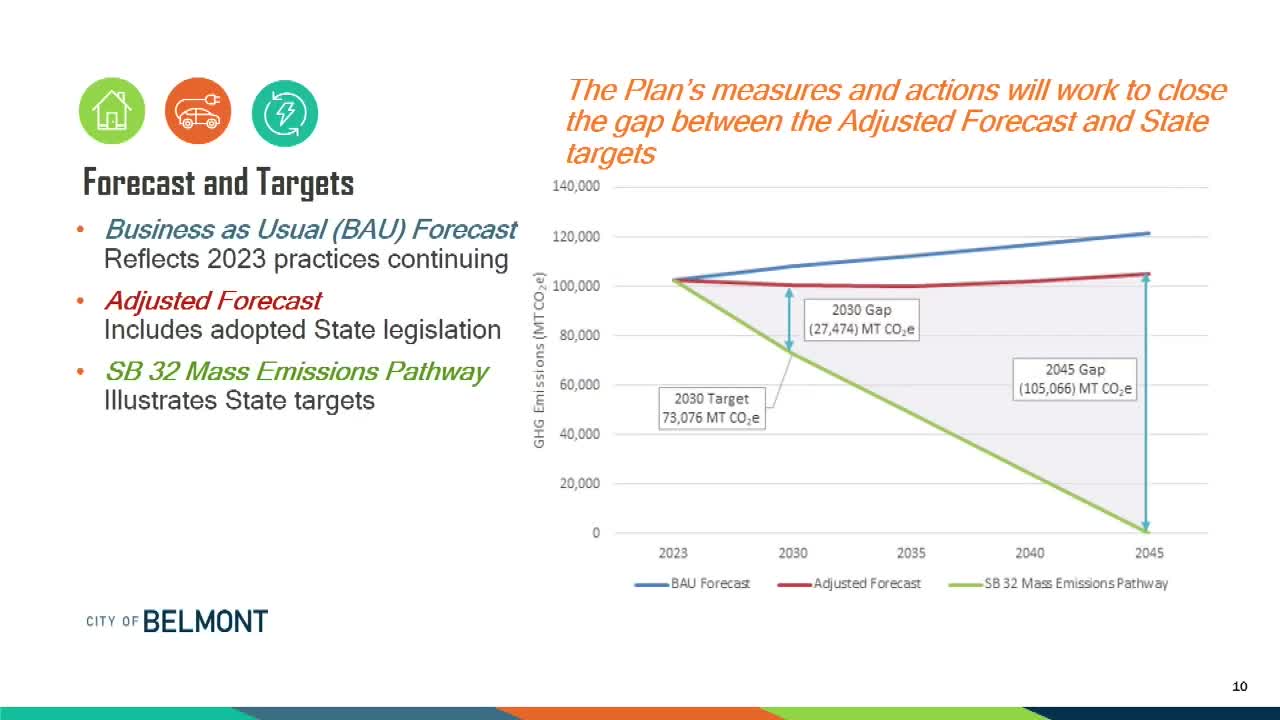Climate Action Plan Aims to Bridge Emissions Gap by 2045 in Belmont
September 02, 2025 | Belmont City, San Mateo County, California
This article was created by AI summarizing key points discussed. AI makes mistakes, so for full details and context, please refer to the video of the full meeting. Please report any errors so we can fix them. Report an error »

During the recent Belmont City Planning Commission meeting, officials discussed critical strategies to address climate change impacts and greenhouse gas emissions in the community. The meeting highlighted the city's commitment to aligning with state legislation aimed at reducing emissions, which is essential for managing the effects of population growth on the environment.
The discussion centered around two key components: mitigation of greenhouse gas emissions and adaptation to climate impacts. The mitigation strategy involves a target pathway, represented by a green line, aiming for zero emissions by 2045. This ambitious goal is contrasted with the current trajectory, indicated by a red line, which shows that while emissions are expected to rise slightly due to population growth, they can be offset by state legislation.
On the adaptation front, the city plans to integrate findings from the safety element update into its climate action plan. This integration is crucial as Belmont faces significant climate challenges, including extreme heat, wildfires, and the associated risks of wildfire smoke. Residents have already felt the effects of these issues, underscoring the urgency of the city's response.
The meeting also addressed the dual threats of flooding and drought, as climate models predict less overall precipitation but with more intense rainfall events. This scenario could lead to both flooding and drought conditions in Belmont. Additionally, the potential for sea level rise poses risks of flooding and saltwater intrusion in certain areas of the bay.
As Belmont moves forward with its climate action plan, the focus remains on closing the gap between current emissions and state targets, while also preparing for the inevitable impacts of climate change. The outcomes of this meeting reflect a proactive approach to safeguarding the community's future against environmental challenges.
The discussion centered around two key components: mitigation of greenhouse gas emissions and adaptation to climate impacts. The mitigation strategy involves a target pathway, represented by a green line, aiming for zero emissions by 2045. This ambitious goal is contrasted with the current trajectory, indicated by a red line, which shows that while emissions are expected to rise slightly due to population growth, they can be offset by state legislation.
On the adaptation front, the city plans to integrate findings from the safety element update into its climate action plan. This integration is crucial as Belmont faces significant climate challenges, including extreme heat, wildfires, and the associated risks of wildfire smoke. Residents have already felt the effects of these issues, underscoring the urgency of the city's response.
The meeting also addressed the dual threats of flooding and drought, as climate models predict less overall precipitation but with more intense rainfall events. This scenario could lead to both flooding and drought conditions in Belmont. Additionally, the potential for sea level rise poses risks of flooding and saltwater intrusion in certain areas of the bay.
As Belmont moves forward with its climate action plan, the focus remains on closing the gap between current emissions and state targets, while also preparing for the inevitable impacts of climate change. The outcomes of this meeting reflect a proactive approach to safeguarding the community's future against environmental challenges.
View full meeting
This article is based on a recent meeting—watch the full video and explore the complete transcript for deeper insights into the discussion.
View full meeting
